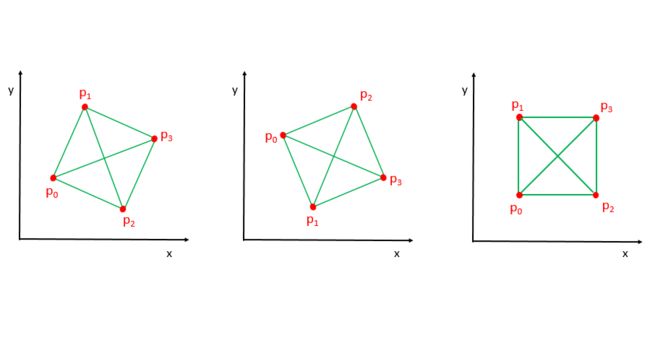leetcode 593. Valid Square
Given the coordinates of four points in 2D space, return whether the four points could construct a square.
The coordinate (x,y) of a point is represented by an integer array with two integers.
Example:
Input: p1 = [0,0], p2 = [1,1], p3 = [1,0], p4 = [0,1] Output: True
Note:
- All the input integers are in the range [-10000, 10000].
- A valid square has four equal sides with positive length and four equal angles (90-degree angles).
- Input points have no order.
package leetcode;
import java.util.Arrays;
public class Valid_Square_593 {
public boolean validSquare(int[] p1, int[] p2, int[] p3, int[] p4) {
int[] allBian=new int[]{
getDistance2(p1, p2),getDistance2(p1, p3),getDistance2(p1, p4),
getDistance2(p2, p3),getDistance2(p2, p4),getDistance2(p3, p4)
};
Arrays.sort(allBian);
if(allBian[0]==0){
return false;
}
//保证有4个边相同,a^2可能比a大,也可能比a小
if(allBian[0]==allBian[3]||allBian[2]==allBian[5]){
//a^2比a大
if(allBian[0]==allBian[3]){
//使用勾股定理:a^2+b^2=c^2,而a=b,所以2a^2=c^2
if(allBian[0]*2==allBian[5]){
return true;
}
}
else{//a^2比a小
if(allBian[5]*2==allBian[0]){
return true;
}
}
}
return false;
}
//返回距离的平方
int getDistance2(int[] p1,int[] p2){
int distance2=(p1[0]-p2[0])*(p1[0]-p2[0])+(p1[1]-p2[1])*(p1[1]-p2[1]);
return distance2;
}
public static void main(String[] args) {
// TODO Auto-generated method stub
Valid_Square_593 v = new Valid_Square_593();
int[] p1 = new int[] { 0, 0 };
int[] p2 = new int[] { 0, 0 };
int[] p3 = new int[] { 0, 0 };
int[] p4 = new int[] { 0, 0 };
System.out.println(v.validSquare(p1, p2, p3, p4));
}
}大神说:如果4点连成的是正方形,那么这4个点之间的6条线,一定有4条相等,另外2条也相等,且4条的长度不等于2条的长度。4条是边,2条是斜边。
public class Solution {
public boolean validSquare(int[] p1, int[] p2, int[] p3, int[] p4) {
HashMap map = new HashMap<>();
int a12 = getDistanceSquare(p1, p2);
int a13 = getDistanceSquare(p1, p3);
int a14 = getDistanceSquare(p1, p4);
int a23 = getDistanceSquare(p2, p3);
int a24 = getDistanceSquare(p2, p4);
int a34 = getDistanceSquare(p3, p4);
if (a12 == 0 || a13 == 0 || a14 == 0 || a23 == 0 || a24 == 0 || a34 == 0){
return false;
}
map.put(a12, map.getOrDefault(a12, 0) + 1);
map.put(a13, map.getOrDefault(a13, 0) + 1);
map.put(a14, map.getOrDefault(a14, 0) + 1);
map.put(a23, map.getOrDefault(a23, 0) + 1);
map.put(a24, map.getOrDefault(a24, 0) + 1);
map.put(a34, map.getOrDefault(a34, 0) + 1);
return map.size() == 2 && (map.get(a12) == 2 || map.get(a12) == 4);
}
private int getDistanceSquare(int[] a, int[] b) {
return (a[0] - b[0]) * (a[0] - b[0]) + (a[1] - b[1]) * (a[1] - b[1]);
}
} Solution
Approach #2 Using Sorting [Accepted]
我们可以不考虑边的所有可能组合情形,而是根据x坐标大小,来对这4个坐标进行排序。如果4个点能构成正方形,且四个坐标按照x坐标从小到大排序为p0,p1,p2,p3,那么构成的正方形只可能是下面3种情况:
这三种情况下,四条边和斜边都是如下的结论:
-
p0p1, p1p3, p3p2 and p2p0 form the four sides of any valid square.
-
p0p3 and p1p2 form the diagonals of the square.
因此,我们可以比较 p0p1, p1p3, p3p2 and p2p0 的长度,和 p0p3 and p1p2 的长度。(注意,菱形的话两条斜边是不相等的。)
Java
public class Solution { public double dist(int[] p1, int[] p2) { return (p2[1] - p1[1]) * (p2[1] - p1[1]) + (p2[0] - p1[0]) * (p2[0] - p1[0]); } public boolean validSquare(int[] p1, int[] p2, int[] p3, int[] p4) { int[][] p={p1,p2,p3,p4}; Arrays.sort(p, (l1, l2) -> l2[0] == l1[0] ? l1[1] - l2[1] : l1[0] - l2[0]); return dist(p[0], p[1]) != 0 && dist(p[0], p[1]) == dist(p[1], p[3]) && dist(p[1], p[3]) == dist(p[3], p[2]) && dist(p[3], p[2]) == dist(p[2], p[0]) && dist(p[0],p[3])==dist(p[1],p[2]); } }
Complexity Analysis
-
Time complexity : O(1). Sorting 4 points takes constant time.
-
Space complexity : O(1). Constant space is required.
Approach #3 Checking every case [Accepted]
Algorithm
我们考虑所有组合的可能性(点 按照顺时针排序):
在图中,相同背景色代表“边集合和斜边集合”相同的情况。我们发现只有3种与众不同的情形。因此,没必要考虑24种情况,只需要看这3种情况。
Java
public class Solution { public double dist(int[] p1, int[] p2) { return (p2[1] - p1[1]) * (p2[1] - p1[1]) + (p2[0] - p1[0]) * (p2[0] - p1[0]); } public boolean check(int[] p1, int[] p2, int[] p3, int[] p4) { return dist(p1,p2) > 0 && dist(p1, p2) == dist(p2, p3) && dist(p2, p3) == dist(p3, p4) && dist(p3, p4) == dist(p4, p1) && dist(p1, p3) == dist(p2, p4); } public boolean validSquare(int[] p1, int[] p2, int[] p3, int[] p4) { return check(p1, p2, p3, p4) || check(p1, p3, p2, p4) || check(p1, p2, p4, p3); } }
Complexity Analysis
-
Time complexity : O(1). A fixed number of comparisons are done.
-
Space complexity : O(1). No extra space required.

